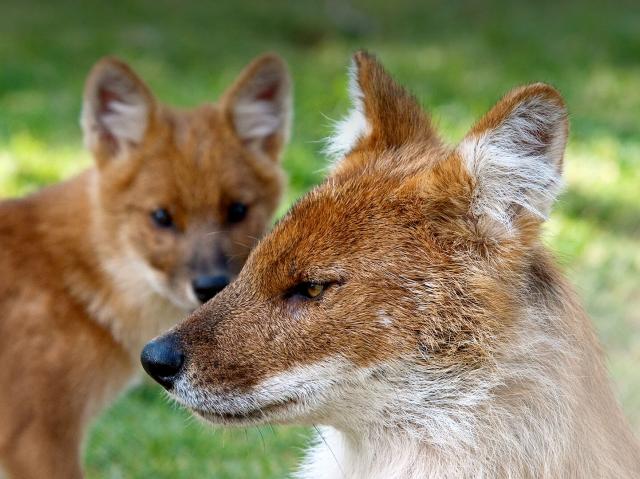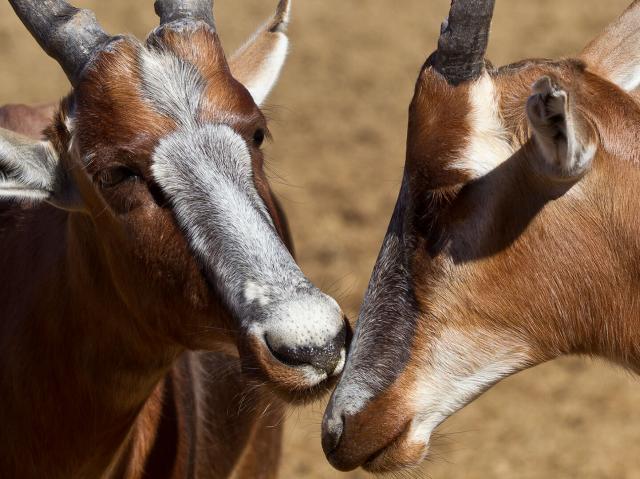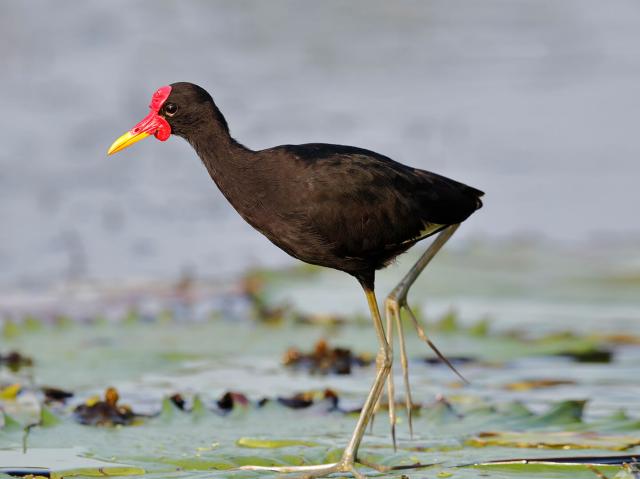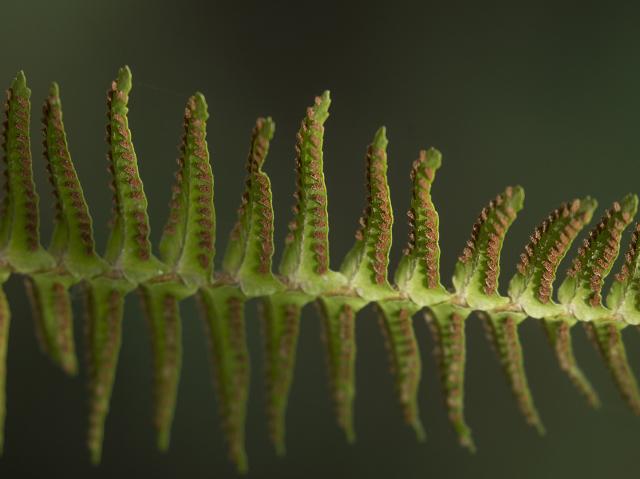
Sloth Bear

- CLASS: Mammalia (Mammals)
- ORDER: Carnivora
- FAMILY: Ursidae
- GENUS: Melursus
- SPECIES: ursinus
- SUBSPECIES: Indian sloth bear Melursus ursinus ursinus, Sri Lankan sloth bear Melursus ursinus inornatus

ABOUT
It's a what? Sloth bears are a bit misleading by name. They are not related to sloths, and they are not slow moving. In fact, they’re agile bears that can run faster than a human and will attack if surprised. It was a European zoologist, George Shaw, who named the sloth bear for its long, thick claws and unusual teeth. He thought that the bear was related to the tree sloth due to these features.
The sloth bear is a bit messy in appearance. It has long, rough, unruly hair around its ears, shoulders, and neck that is cinnamon to dark brown in color. The pale muzzle and a flexible nose sniff out interesting smells. The sloth bear often has a white patch of fur on its chest in the shape of a Y, O, or U. With a stocky body and powerful legs, this medium-size bear is able to climb trees. The sloth bear cannot pull in its claws like a cat's, so it looks a bit awkward when walking.
HABITAT AND DIET
Bears extraordinaire: Sloth bears adapt well to many different habitats. They live in the hot, dry grasslands and forests of South Asia and the Indian subcontinent. Does having a thick and shaggy coat seem odd for this environment? That coat protects them from being bitten by their favorite food—termites! It also gives sloth bear cubs something to grip when their mothers carry them on their backs.
These bears are unusual because they do not hibernate like some bears. They often sleep in caves and near rivers when available. Sloth bears tend to be nocturnal when living around humans. But without human disturbance nearby, they are often active during the day.
The sloth bear has a nose for sniffing out food but it cannot see or hear as well as other bears. It is not aggressive, but it will defend itself against tigers, leopards, and other bears by standing on its back legs and using its teeth and claws.
While it might have a “bear” of an appetite, the sloth bear has more in common with an anteater than other bears. Even though it is omnivorous and dines on fruit when available, the sloth bear also eats termites and ants. As an adaptation for this creepy-crawly diet, the bear has few hairs on its nose and can open and close its nostrils as needed. This keeps bugs from crawling up the bear's nose while it eats!
Large, thick 3-inch (8-centimeter) claws come in handy for ripping apart termite nests in soil, old logs, or trees. This is a noisy activity. In fact, sloth bears are well known for being noisy bears, especially while they eat. A large gap between the upper teeth makes the perfect space for sucking up termites. Like vacuum cleaners, the bears' lips and tongue create a powerful suction and loud slurping, sucking sounds. They also eat honey, sugarcane, flowers, eggs, grubs, and carrion.
FAMILY LIFE
The courtship of sloth bears is a brief encounter. Living a solitary life most of the time, the sloth bear makes an exception during the breeding season, May through July. The female then stays in a den for six to seven months until she gives birth, usually to two cubs. The male does not help raise the cubs.
Remember the sloth bear’s long coat? It helps a mother sloth bear as she carries her young on her back. The long hair is easier for her cubs to grip, and they can hold on better while Mom looks for food. Riding on the mother’s back is thought to provide the cubs protection from predators. As they get larger, the cubs spend more time on the ground. They nurse for about a year and stay with their mother until they are 1.5 to 2.5 years old.
Sloth bears aren’t very vocal, but can make an impressive roar if needed for defense. A mother with a cub clinging to her back was observed scaring off not one but two tigers with her roar! One of our sloth bears, Kenny, used to blow “raspberries.” It seemed to be his way of being social. If a wildlife care specialists blew Kenny a raspberry, he’d blow one right back!
CONSERVATION
Slippery slope: We know little about sloth bear behavior and ecology. Habitat encroachment is the greatest threat to sloth bears. But illegal hunting and capture still threaten sloth bears in their native habitat. The International Bear Association works to promote sloth bear conservation in the local communities.
Currently, the sloth bear remains vulnerable. This, in large part, is due to poaching. Some people believe that sloth bear gall bladders can cure certain illnesses, which is not true. Habitat destruction also plays a major role in the decline of sloth bears in Asia.
Sloth bears kill or maim more people per year than any other type of bear. This is largely due to the fact that they live in an area where there are lots of people. Some people go out of their way to find and kill the innocent bears. This is unfortunate, because sloth bears are shy and would rather run away from human encounters. They are aggressive only when startled or confronted. Even though a hunting ban is in place, sloth bear cubs are still captured and forced to "dance" for audiences. Thanks to the tireless efforts of some nature organizations within India, this is significantly less common than it used to be.
Sloth bears play an important role in their habitats as seed dispersers. San Diego Zoo Wildlife Alliance started studying sloth bears to learn more about their behavior and needs. We are partners with India’s Wildlife SOS sloth bear rescue facility, helping to fund conservation science and education programs.
This unique bear is worth saving! Every measure you take is one small step for the sloth bear but a big step toward our world and the wildlife that inhabit it. By supporting San Diego Zoo Wildlife Alliance, you are our ally in saving and protecting wildlife worldwide.
LIFE SPAN
15.8 years median life expectancy
YOUNG
Gestation: 4 to 7 months, including period of delayed implantation
Number of young at birth: 1 to 2, rarely 3
Weight at birth: 14 ounces (400 grams) average
Age of maturity: 3 to 5 years
SIZE
Length: 4.5 to 6.2 feet (1.4 to 1.9 meters)
Height: 2 to 3 feet (.6 to .9 meters) tall at the shoulder
Weight: Females - 110 to 210 pounds (50 to 95 kilograms); males, 154 to 320 pounds (70 to 145 kilograms)
FUN FACTS
Sloth bears are the only bears that carry their young around on their back.
Talk about noisy! Sucking sounds the sloth bear makes while eating can be heard up to 330 feet (100 meters) away.
A sloth bear can close its nostrils while it sucks up ants and termites with its mouth, so the insects don’t crawl up its nose.
It was once believed that a sloth bear was being aggressive and threatening when it stood up on its hind feet, but often the bears are just getting a better view and checking the air for whiffs of food or danger.










